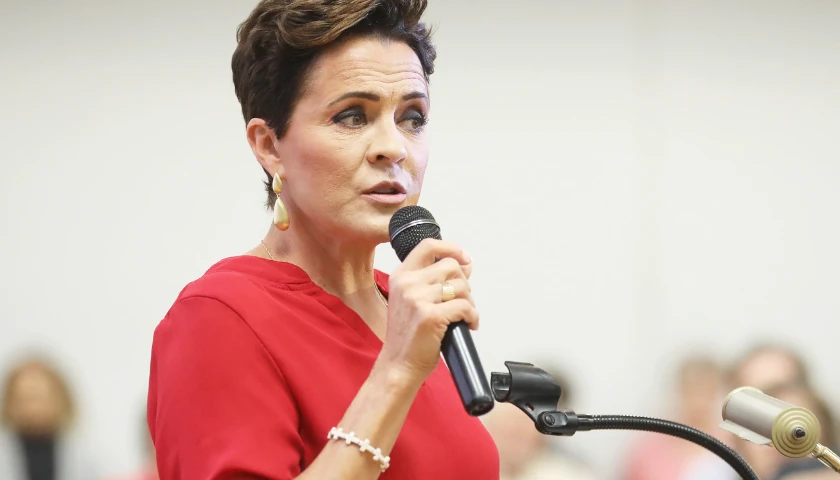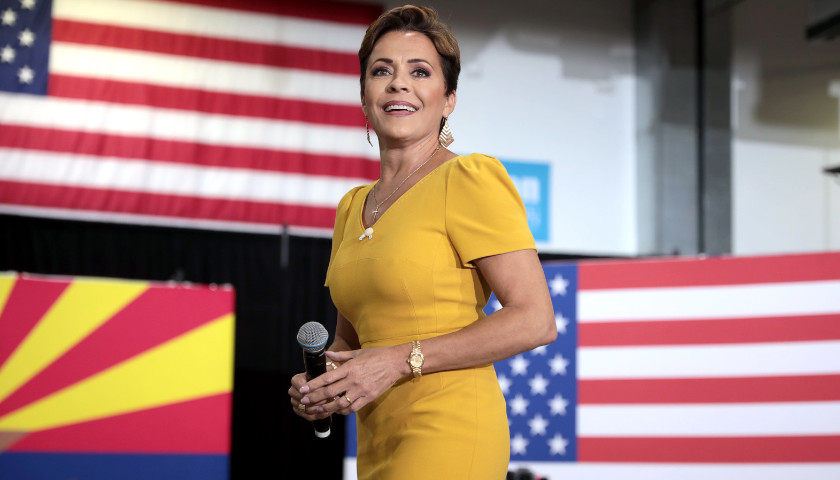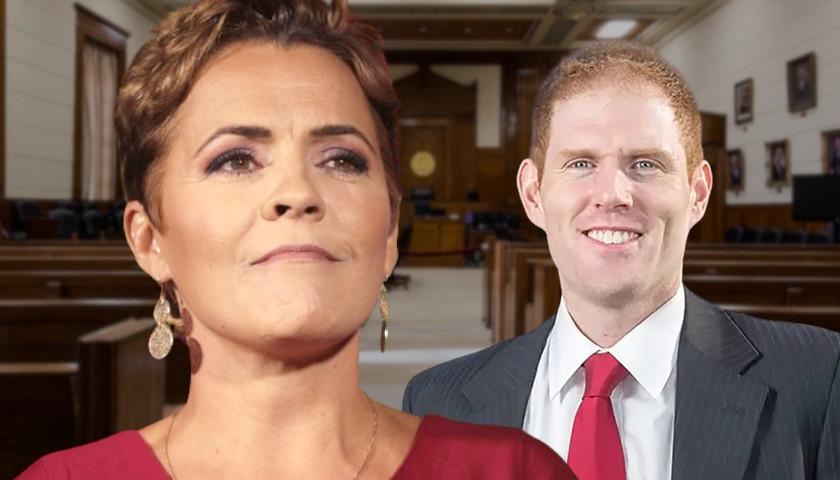An Arizona Court of Appeals panel of three judges issued a 23-page unpublished decision last week, affirming a trial court’s dismissal of Kari Lake’s Rule 60(b) second election lawsuit. The court claimed that Lake’s Rule 60(b)(3) motion, which means requesting a second trial based on newly found evidence, constituted merely relitigating her first election lawsuit.
The court said that instead, “The focus must rather be on the fraud or misconduct that prevents a litigant from trying otherwise meritorious claims.” However, the court ignored Lake’s evidence of misconduct and affirmed the high standard the trial court judge set for election contests, which is not found in Arizona case law.
The trial court judge, Maricopa County Superior Court Judge Peter Thompson, had dismissed eight of Lake’s 10 counts “for failure to state a claim, for undue delay, as duplicative, as outside the scope of an election contest, or for some combination thereof.”
Lake argued in one of her counts that was dismissed that she discovered after her initial election challenge that Maricopa County workers were illegally verifying voters’ signature affidavits on the ballot envelopes, comparing them to any previous signature on record, not their initial voter registration signature as required by law. In Arizona Free Enterprise Club v. Fontes, Yavapai Superior Court Judge John Napper ruled that not using voters’ original signatures as required by statute on their voter registrations to compare their ballot affidavit signatures was illegal.
Thompson dismissed this as barred by the doctrine of laches, stating Lake knew months before the election about the illegal signature verification, so they could have objected then. The court cited an obscure press release by Maricopa County Recorder Stephen Richer, which mentioned deep into the text that signature reviewers would compare the signatures to multiple previous signatures.
The Arizona Supreme Court held that Thompson erred, agreeing with Lake on appeal that she could not have known about the illegal actions prior to the election. The court vacated the Arizona Court of Appeals’ opinion and remanded the issue to the trial court, with instructions to assess whether the wrongdoing might have changed the election results.
Thompson held a second bench trial on remand and claimed that Lake failed to show “clear and convincing” evidence that Maricopa County failed to conduct signature verification on mail-in ballots as required by § 16-550(A).
Thompson admitted that Lake’s Rule 60(b)(3) motion was filed timely on three of her counts. However, the appeals court said it was skeptical that Rule 60(b)(3) motions can be filed “within a reasonable time” due to the speediness of elections.
The Arizona Supreme Court has reversed elections months after they were over, including a gubernatorial race in 1916. In Hunt v. Campbell, which involved accusations of election wrongdoing, the court issued an opinion almost a year after the incumbent had been in office, ordering him out and putting in his opponent instead.
The appeals court laid out the test that Thompson initially set for Lake to win her election challenge, which was unprecedented and not part of Arizona law. Thompson said for the first trial, Lake would have to prove with “‘clear and convincing evidence’ ‘that 1) the malfeasant person was a covered person under (A)(1); 2) the printer malfunctions caused by this individual directly resulted in identifiable lost votes for [Lake]]; and 3) that these votes would have affected the outcome of the election.’”
This is not the standard for overturning elections in Arizona. The two dispositive cases in this area are Miller v. Picacho Elementary Sch. Dst. No. 33 and Reyes v. Cuming. In Reyes, which relied heavily on Miller, the Arizona Court of Appeals held that the standard is whether the illegal actions taken by election workers in regards to failing to conduct signature verification could have merely cast doubt on the results of the election. The court stated that “because A.R.S. section 16-550(A) is a non-technical statute and because absentee ballots counted in violation of that statute have rendered the outcome of this election uncertain, we reverse the trial court’s judgment and remand with directions to set aside the election.”
There were no additional requirements, unlike Thompson’s standard.
The Reyes court stressed that violations of the signature verification statute could not be ignored. “Although the trial court found that it would be impracticable for the Recorder to comply with A.R.S. section 16-550(A), we hold as a matter of law that such a finding does not excuse the complete non-compliance with this non-technical statute. [E]lection statutes are mandatory, not ‘advisory,’ or else they would not be law at all,” the court held, citing Miller.
The Reyes court added that “there was no evidence showing that any absentee ballots were cast by persons other than registered voters.” However, it found, “The purpose of A.R.S. section 16-550(A) is to prevent the inclusion of invalid votes. Without the proper signature of a registered elector on the outside, an absentee ballot is void and may not be counted. A.R.S. § 16-552(B).”
The appeals court said Thompson erred by requiring a showing of fraud. Regarding Thompson’s decision, the justices said, “Lake fails to show that the court’s conclusion — that she had not proved by clear and convincing evidence a knowing fraud by Maricopa County — was error.” However, “Lake is correct that knowing fraud is not required and that it is possible for a movant under Rule 60(b)(3) to obtain relief by showing unintentional misconduct.”
Yet the court held Lake to a high standard, “Lake was still required to prove the alleged misconduct — whether knowing or inadvertent — by clear and convincing evidence and to demonstrate that the misconduct substantially interfered with her ability to fully present her claims.”
The appeals court admitted its decision affirming the trial court’s dismissal of Lake’s first lawsuit, “We noted that Lake had ‘presented no evidence that voters whose ballots were unreadable by on-site tabulators were not able to vote,’ and only ‘sheer speculation’ that issues on election day discouraged ‘a substantial number of predominantly Lake voters” from voting.”
Election fraud experts who investigated the botched 2022 election in Maricopa County concluded that 300,000 Republican voters were disenfranchised. State Representative Justin Heap (R-Mesa), who is running against Richer for Maricopa County Recorder, said during his campaign launch speech, “[T]he issue we have is in the last election, 300,000 active Republican voters did not mail in their ballot and did not vote on Election Day.”
The appeals court said it “determined that Lake’s expert witness — whose testimony amounted to an opinion that ‘a population equaling approximately 16% of the total election-day turnout across Maricopa County had been deprived of their right to vote, and that the deprivation derived from printer/tabulator issues’ — had no reasonable basis for his claims of disenfranchisement.”
The court ignored the evidence of voters who said they could no longer wait in line, so they left without voting, or voters who drove to a second polling location to vote only to get there too late as it was closing. The court also ignored voters who said they looked up the status of their ballots on the elections’ website after voting and saw that they had not been counted.
Another way the appeals court dismissed Lake’s new evidence was to claim that “the statute did not permit Lake to amend her pleadings to assert a new claim after the time to bring an election contest had passed, even to conform to evidence presented at trial.”
The appeals court said the trial court found that Lake argued in her Rule 60(b)(3) motion that “evidence would show that Maricopa County had failed to conduct logic and accuracy testing on the tabulators in accordance with Arizona law, ‘and afterwards, secretly tested all 446 vote center tabulators’ and had known that ‘260’ of them would fail.” She also “argued that her evidence would show that a Maricopa County official had falsely testified about BOD ‘printer failures’ that, as alleged, caused tabulators to malfunction on election day.”
The appeals court claimed that Lake could have discovered the evidence sooner. Her expert, Clay Parikh, had the system logs at the time of the first trial but did not finish his analysis until after the trial. The court said it didn’t care that Parikh did not have time to finish his lengthy, exhaustive analysis. “Regardless of the expert’s diligence, Rule 60(b)(2) does not provide relief for one who possesses documents at the time of an election contest, but does not have the time, for whatever reason, to analyze them,” the ruling said.
The court said Maricopa County’s report admitting problems with the ballot on demand (BOD) printers didn’t constitute new evidence since the report didn’t exist during the first trial. Nor did the court agree that the information Lake received from public records requests received after the trial constituted new evidence.
The court did not dispute Lake’s claim that Maricopa County failed to perform Logic & Accuracy (L&A) testing on the voting machine tabulators or her assertion that they falsely certified they had. Lake later identified this misconduct. Maricopa County Co-Elections Director Scott Jarrett falsely testified at trial that they did L&A testing. The court agreed this claim was not an improper amendment to the complaint as Thompson ruled.
However, the court dismissed the evidence as “merely relitigating the underlying election contest itself.”
The court also rejected the inconsistent testimony by Jarrett regarding whether 20-inch ballots were printed with 19-inch ballot images on Election Day. On the first day of the original trial, Jarrett said they weren’t. On the second day, he admitted they were. The court excused Jarrett, “At best, this is a misunderstanding between an attorney and a witness that was ironed-out during a trial. Lake fails to show how this exchange constitutes misconduct.”
The court said it accepted as a fact “that Jarrett misrepresented the degree to which nineteen-inch ballot images were erroneously printed on election day and that Maricopa County did not perform logic and accuracy testing on voting center tabulators on the date certified.” However, it claimed that “Lake fails to show that this alleged misconduct would have substantially interfered with her ability to present a meritorious claim.”
Parikh’s report found that at least 8,000 ballots were not counted. The court said since this was less than the margin Lake lost by, “On this basis alone we can conclude that the court did not err in denying the Rule 60(b)(3) motion on its merits.”
The court said, “What Lake needed to do at trial was provide competent evidence that the ballots did not match the canvass in numbers that could have resulted in her election day victory.” However, the court ignored all of the other evidence during Lake’s litigation, casting doubt on hundreds of thousands of ballots, such as 35,000 lacking chain of custody at Maricopa County’s third-party vendor, Runbeck Election Services. Each one constitutes a class 2 misdemeanor, which has never been disputed by Maricopa County or Runbeck.
The court blew off Lake’s claim about the lack of legal signature certification, which became an issue after a video was released showing a Maricopa County Elections employee comparing and approving voters’ signatures in less than one second. The court dismissed the evidence, stating that A.R.S. “16-550 does not delineate how much time must be spent comparing a voter’s signature with a voter’s records,” so “there was no failure to comply with the law.”
The court went into extensive detail justifying the 1-second signature reviews, even though the reviewers were instructed to compare them to the voters’ original signature for voter registration and multiple signatures that had come in on ballot signature envelopes over the years and stored.
“Lake contends that training materials and guides published by the Secretary of State and Maricopa County inform what a proper ‘objective’ comparison requires, which includes evaluating broad or local characteristics before approving a signature,” the court said.
The court added that those guides did not matter.
“But Lake did not show that the applicable signature verification procedures were not performed, let alone that non-performance affected an outcome-determinative number of votes,” the ruling said.
The appeals court echoed the trial court’s findings on the 1-second signature reviews. The justices said, “In the [lower] court’s ruling, it specifically weighed Lake’s evidence against testimony offered by election officials, and found that the election officials’ testimony ― that meaningful verification had occurred ― was more credible.” They added, “Hobbs presented contradicting evidence through witness testimony tending to show that Maricopa County had complied with § 16-550(A).”
The appeals court agreed with the trial court that Reyes was not dispositive since the 1-second signature verification was not as bad as Reyes’s complete lack of signature verification. The justices stated, “Pervasive non-compliance was not found, let alone excused.”
However, in Reyes, the court held that even substantial compliance with A.R.S. 16-550(A) constitutes an abuse of discretion.
Lake is expected to appeal to the Arizona Supreme Court.
– – –
Rachel Alexander is a reporter at The Arizona Sun Times and The Star News Network. Follow Rachel on Twitter / X. Email tips to [email protected].
Photo “Kari Lake” by Gage Skidmore. CC BY-SA 2.0.





